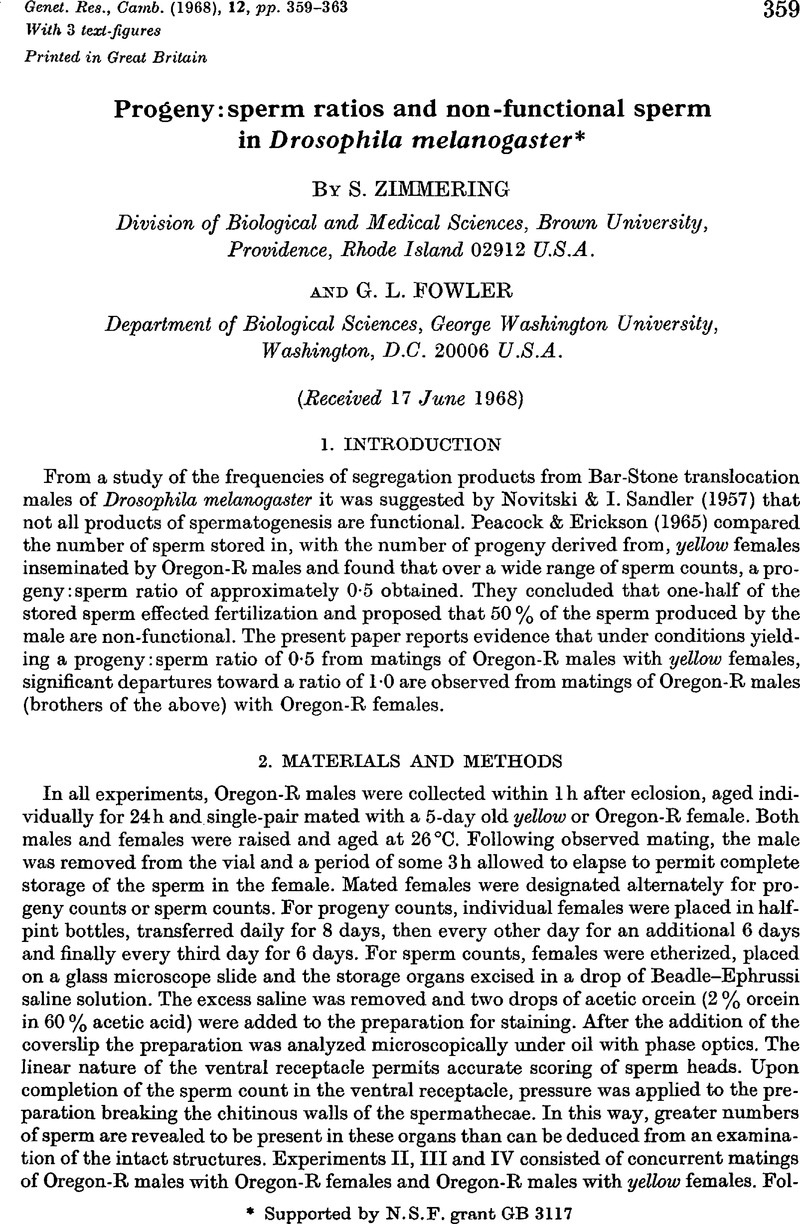Crossref Citations
This article has been cited by the following publications. This list is generated based on data provided by Crossref.
Denell, R. E.
and
Judd, B. H.
1969.
Segregation distorter in D. melanogaster males: An effect of female genotype on recovery.
Molecular and General Genetics MGG,
Vol. 105,
Issue. 3,
p.
262.
Zimmering, S.
Barnabo, J. M.
Femino, J.
and
Fowler, G. L.
1970.
Progeny: Sperm ratios and segregation-distorter inDrosophila melanogaster.
Genetica,
Vol. 41,
Issue. 1,
p.
61.
Jaylet, A.
1971.
Cr�ation d'une lign�e homozygote pour une translocation r�ciproque chez l'Amphibien Pleurodeles waltlii.
Chromosoma,
Vol. 34,
Issue. 4,
p.
383.
Douglas, Lee T.
1971.
Meiosis VIII: Segregation matrix methods applied to meiotic drive in Drosophila melanogaster males with an SC 4-SC 8 inverted X.
Genetica,
Vol. 42,
Issue. 1,
p.
104.
Olivieri, G.
Tanzarella, C.
and
Micheli, A.
1972.
On the relationship between stored sperm and progeny produced in females of Drosophila melanogaster.
Genetica,
Vol. 43,
Issue. 1,
p.
98.
Douglas, L. T.
and
van Meekeren, M. E.
1972.
Patterned disjunction in Drosophila melanogaster. I. Assortment of SPA pol /+ and X, Y in the stock N1.
Genetica,
Vol. 43,
Issue. 1,
p.
43.
Peacock, W.J.
and
Miklos, George L. Gabor
1973.
Vol. 17,
Issue. ,
p.
361.
Fowler, G.L.
1973.
Vol. 17,
Issue. ,
p.
293.
Wallace, H
1974.
Chiasmata have no effect on fertility.
Heredity,
Vol. 33,
Issue. 3,
p.
423.
Newton, M. E.
Wood, R. J.
and
Southern, D. I.
1976.
A cytogenetic analysis of meiotic drive in the mosquito, Aedes aegypti (L.).
Genetica,
Vol. 46,
Issue. 3,
p.
297.
Gilbert, Donald G.
Richmond, Rollin C.
and
Sheehan, Kathy B.
1981.
STUDIES OF ESTERASE 6 IN
DROSOPHILA MELANOGASTER
. V. PROGENY PRODUCTION AND SPERM USE IN FEMALES INSEMINATED BY MALES HAVING ACTIVE OR NULL ALLELES
.
Evolution,
Vol. 35,
Issue. 1,
p.
21.
Turner, Monte E.
and
Anderson, Wyatt W.
1983.
MULTIPLE MATING AND FEMALE FITNESS IN
DROSOPHILA PSEUDOOBSCURA
.
Evolution,
Vol. 37,
Issue. 4,
p.
714.
GROMKO, MARK H.
GILBERT, DONALD G.
and
RICHMOND, ROLLIN C.
1984.
Sperm Competition and the Evolution of Animal Mating Systems.
p.
371.
Trevitt, Sara
Fowler, Kevin
and
Partridge, Linda
1988.
An effect of egg-deposition on the subsequent fertility and remating frequency of female Drosophila melanogaster.
Journal of Insect Physiology,
Vol. 34,
Issue. 8,
p.
821.
Yamagishi, Masaaki
It�, Yosiaki
and
Tsubaki, Yoshitaka
1992.
Sperm competition in the melon fly,Bactrocera cucurbitae (Diptera: Tephritidae): Effects of sperm ?longevity? on sperm precedence.
Journal of Insect Behavior,
Vol. 5,
Issue. 5,
p.
599.
Markow, Therese Ann
1997.
Assortative fertilization in
Drosophila
.
Proceedings of the National Academy of Sciences,
Vol. 94,
Issue. 15,
p.
7756.
Birkhead, T. R.
1998.
CRYPTIC FEMALE CHOICE: CRITERIA FOR ESTABLISHING FEMALE SPERM CHOICE.
Evolution,
Vol. 52,
Issue. 4,
p.
1212.
Howard, Daniel J.
1999.
Conspecific Sperm and Pollen Precedence and Speciation.
Annual Review of Ecology and Systematics,
Vol. 30,
Issue. 1,
p.
109.
Price, Catherine S. C.
Kim, Christine H.
Posluszny, Joseph
and
Coyne, Jerry A.
2000.
MECHANISMS OF CONSPECIFIC SPERM PRECEDENCE IN DROSOPHILA.
Evolution,
Vol. 54,
Issue. 6,
p.
2028.
Price, Catherine S. C.
Kim, Christine H.
Posluszny, Joseph
and
Coyne, Jerry A.
2000.
MECHANISMS OF CONSPECIFIC SPERM PRECEDENCE IN DROSOPHILA.
Evolution,
Vol. 54,
Issue. 6,
p.
2028.





